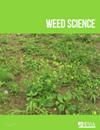Integrating Weed-Suppressive Cultivar and Cover Crops for Weed Management in Organic Sweetpotato Production
IF 2.1
2区 农林科学
Q2 AGRONOMY
引用次数: 0
Abstract
Abstract Field studies were conducted in 2021 in Kibler and Augusta, AR, to determine the effect of winter cover crops and cultivar selection on weed suppression and sweetpotato [Ipomoea batatas (L.) Lam.] yield. The split-split-plot studies evaluated three cover crops [cereal rye (Secale cereale L.) + crimson clover (Trifolium incarnatum L.)], [winter wheat (Triticum aestivum L.) + crimson clover], and fallow; weeding (with or without); and four sweetpotato cultivars (‘Heartogold’, ‘Bayou-Belle-6’, ‘Beauregard-14’, and ‘Orleans’). Heartogold had the tallest canopy, while Beauregard-14 and Bayou Belle-6 had the longest vines at 5 and 8 wk after sweetpotato transplanting. Sweetpotato canopy was about 20% taller in weedy plots compared with the hand-weeded treatment, and vines were shorter under weed interference. Canopy height and vine length of sweetpotato cultivars were not related to weed biomass suppression. However, vine length was positively correlated to all yield grades (r > 0.5). Weed biomass decreased 1-fold in plots with cover crops compared with bare soil at Augusta. Cover crop biomass was positively correlated with jumbo (r = 0.29), no. 1 (r = 0.33), and total sweetpotato yield (r = 0.34). Jumbo yield was affected the most by weed pressure. On average, sweetpotato total yield was reduced by 80% and 60% with weed interference in Augusta and Kibler, respectively. Bayou Belle-6 was the high-yielding cultivar without weed interference in both locations. Bayou Belle-6 and Heartogold were less affected by weed interference than Beauregard-14 and Orleans.有机甘薯杂草管理中杂草抑制品种与覆盖作物的整合
摘要2021年在安大略省Kibler和Augusta进行了实地研究,以确定冬季覆盖作物和品种选择对杂草抑制和甘薯产量的影响。分块研究评估了三种覆盖作物[谷类黑麦(Secale cereale L.)+深红色三叶草(Trifolium incarnatum L.)]、[冬小麦(Triticum aestivum L.)+深红三叶草]和休耕;除草(有或没有);以及四个甘薯品种(“Heartogold”、“Bayou-Belle-6”、“Beauregard-14”和“Orleans”)。红薯移植后5周和8周,Heartogold的树冠最高,Beauregard-14和Bayou Belle-6的藤蔓最长。与人工除草处理相比,杂草区的甘薯冠层高出约20%,在杂草干扰下,藤蔓更短。甘薯品种的冠层高度和藤长与杂草生物量抑制无关。然而,葡萄藤长度与所有产量等级呈正相关(r>0.5)。与Augusta裸土相比,覆盖作物地块的杂草生物量减少了1倍。覆被作物生物量与块根(r=0.29)、1号(r=0.33)和甘薯总产量(r=0.34)呈正相关,块根产量受杂草压力的影响最大。Augusta和Kibler的甘薯总产量在杂草干扰下平均分别降低了80%和60%。巴优Belle-6是两个地区均无杂草干扰的高产品种。Bayou Belle-6和Heartogold受杂草干扰的影响小于Beauregard-14和Orleans。
本文章由计算机程序翻译,如有差异,请以英文原文为准。
求助全文
约1分钟内获得全文
求助全文
来源期刊

Weed Science
农林科学-农艺学
CiteScore
4.60
自引率
12.00%
发文量
64
审稿时长
12-24 weeks
期刊介绍:
Weed Science publishes original research and scholarship in the form of peer-reviewed articles focused on fundamental research directly related to all aspects of weed science in agricultural systems. Topics for Weed Science include:
- the biology and ecology of weeds in agricultural, forestry, aquatic, turf, recreational, rights-of-way and other settings, genetics of weeds
- herbicide resistance, chemistry, biochemistry, physiology and molecular action of herbicides and plant growth regulators used to manage undesirable vegetation
- ecology of cropping and other agricultural systems as they relate to weed management
- biological and ecological aspects of weed control tools including biological agents, and herbicide resistant crops
- effect of weed management on soil, air and water.
 求助内容:
求助内容: 应助结果提醒方式:
应助结果提醒方式:


